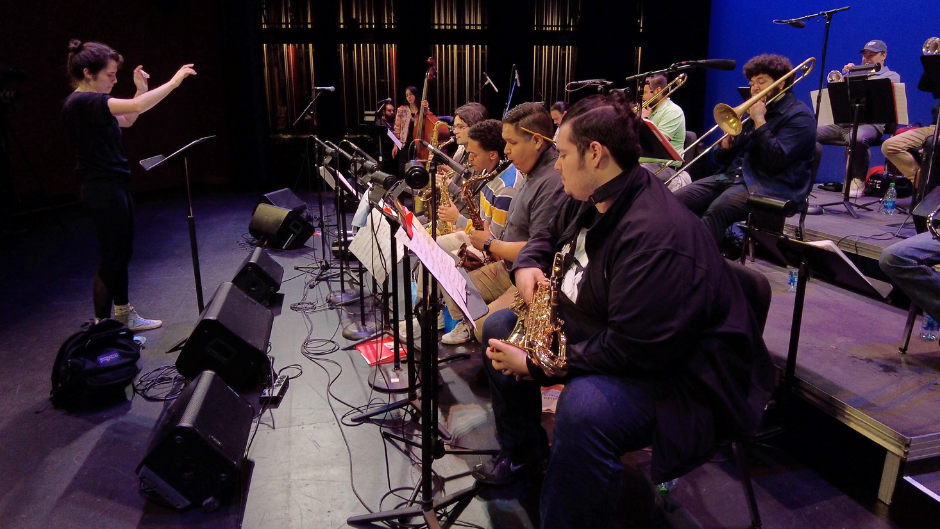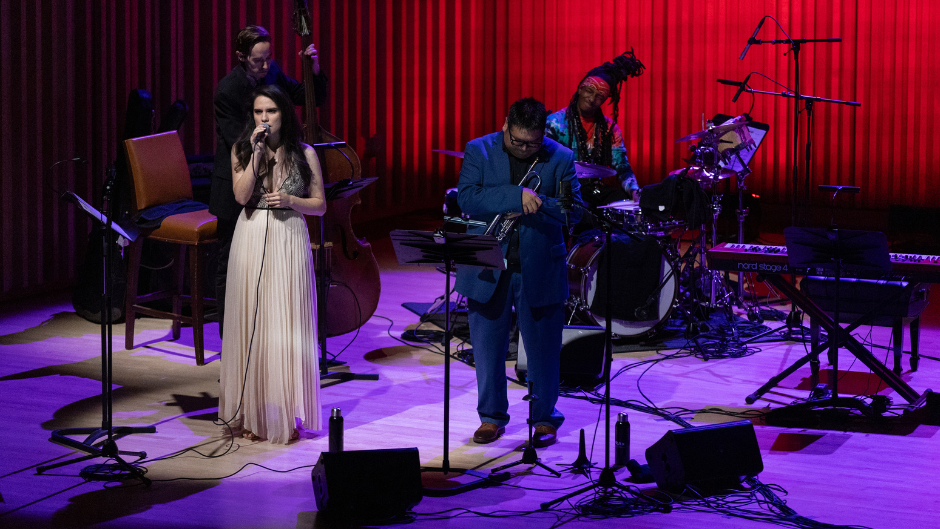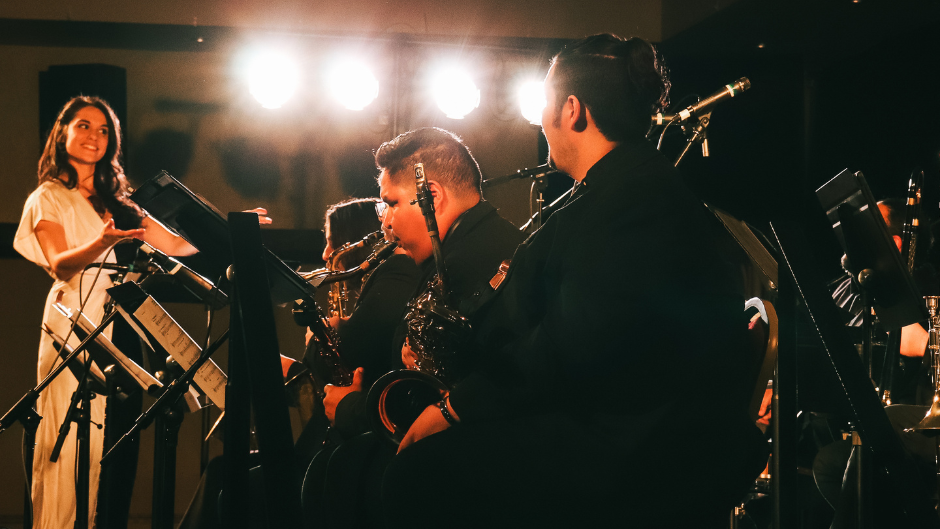Julia Keefe fell in love with jazz as a four-year-old entranced by Billie Holiday’s voice. She shaped her musicianship by studying jazz vocals at the Frost School of Music.
But she found the key to her artistic identity when she discovered that famed jazz singer Mildred Bailey, the “Queen of Swing” who was the first woman to sing with a big band, was, like Keefe, a Native American from the area around Spokane, Washington.
“Mildred Bailey gave me permission to exist in this genre and this space,” said Keefe, a member of the Nez Perce tribe, from her current home in Brooklyn, New York.
Now, Keefe is making waves in the jazz world by championing the hidden influence and history of Indigenous artists in jazz with the Julia Keefe Indigenous Big Band (JKIBB), a 16-member ensemble of Native American musicians that will perform at the Monterey Jazz Festival, a top jazz event, this weekend.
“Indigenous people have been instrumental in the evolution of jazz,” said Keefe. “It’s a chapter not only in jazz but in U.S. history that’s been long overlooked. We’re trying to highlight that this is a part of that history and cultural celebration.”
The number of prominent jazz artists with Indigenous ancestry adds a fascinating new facet to the genre’s story. They include drummer Max Roach, bassists Oscar Pettiford and Charlie Mingus, saxophonists Charles Lloyd and Jim Pepper, trumpeter Don Cherry, and Bebop pioneer Charlie Parker. (Other famous artists who’ve asserted Native American heritage but have not been verified are Cab Calloway, Thelonius Monk, John Lewis, Dizzy Gillespie, Duke Ellington, and Miles Davis.)

“The story of the history and present of jazz is very diverse, but those stories don’t always get told,” said Frost School Associate Musicology Professor Mark Lomanno, who has interviewed Keefe and other Indigenous musicians for a book on inter-cultural collaborations in jazz, and is working to bring her to the Frost School for a presentation. “One of the band’s missions and an important part of Julia’s career is to raise awareness of Native and Indigenous people in jazz, not just as something happening now but as something that happened historically.”
Keefe's family lived on the Nez Perce reservation in Western Idaho when she was a girl. Her mother, an activist and consultant, is Nez Perce, while her father, an attorney, is Caucasian. Keefe's extensive Nez Perce family – her mother had six siblings, giving Keefe over 30 first cousins – immersed her in tribal life. “It was a central focal point during our time on the rez,” said Keefe. “We would go to powwows, to all our cultural celebrations. It was deeply embedded in our family.”
The family moved to nearby Spokane, in Eastern Washington, as Keefe started middle school, where she began studying music. The Lionel Hampton Jazz Festival at the University of Idaho made jazz a big part of music education in the area, fostering Keefe’s attraction to the music. “I loved the improvisation, listening to Billie Holiday, Sarah Vaughn, Ella Fitzgerald,” Keefe said. “Jazz spoke to me.”

As she planned for college, the Frost School spoke loudest. “My voice teacher said if you want to be a jazz singer, this is the program you want,” said Keefe, who graduated from the Frost School in 2012. “It was one of the best decisions I ever made.”
“The beautiful thing about the Frost School is you are so embedded in music and the jazz scene, just soaking up all of this knowledge,” said Keefe. “You don’t really realize until you’re out in the world, wow, I learned so much.”
Keefe discovered Mildred Bailey in high school while researching famed crooner Bing Crosby, a Spokane native who attended Keefe’s school and was close to Bailey, calling her a great singer “who taught me so much.” Known as the Queen of Swing in the 30s and early 40s, Bailey grew up on the nearby Coeur d’Alene reservation and moved to Spokane in her early teens, much like Keefe. As the first female big band singer, Bailey opened doors for other women and was admired by everyone from Tony Bennet to Frank Sinatra.
She was widely believed to be a white woman. However, as Keefe discovered, Bailey was deeply influenced by singing tribal songs with her people. “Mildred once called traditional Indian singing, “a remarkable training and background” for a singer,” Keefe wrote in 2012 to Wynton Marsalis, arguing for Bailey to be admitted to the Jazz Hall of Fame. “Mildred Bailey’s success as a jazz vocalist is grounded in her early vocal training and development from singing traditional tribal songs.”
Although Keefe was inspired by and advocated for Bailey's recognition, she was not ready to put her own heritage into musical action. “I was still learning to be a musician and dealing with insecurity around the marriage of my Indigenous and jazz identity,” said Keefe, who earned a master’s at the Manhattan School of Music in 2019 and had success as a singer, opening for Tony Bennett and Esperanza Spaulding, and performing with artists such as Emmet Cohen (also a Frost School alumnus) and Jim McNeely. “For a long time, if I wasn’t talking about Mildred Bailey, I didn’t talk about being Native American.”

That changed in 2020, during the pandemic lockdown, when she met Navaho jazz musician Delbert Anderson online. They bonded over their shared passion for Indigenous jazz history. In 2021, they received a $40,000 grant from South Arts, a regional arts funder, to start an Indigenous big band. They got an overwhelming response to their call for Indigenous musicians, and the Julia Keefe Indigenous Big Band debuted in May of 2022 at the Washington Center for the Performing Arts in Olympia. A presenter’s showcase at Joe’s Pub in New York in January got them an agent the next day, and the group performed at the Kennedy Center last spring.
Keefe has multiple goals for the JKIBB: to highlight the forgotten history of Indigenous jazz artists, explore the influence of traditional Indigenous music, and showcase original music by band members, sometimes inspired by Native American songs and rhythms. The group performs music associated with Bailey by Jim Pepper, a Kaw and Muscogee Creek saxophonist, composer, and fusion jazz pioneer famed for combining Indigenous music with jazz. Keefe co-directs with Anderson, conducts (digging out notebooks from her introductory conducting course at the Frost School), and sings.
She’s been enormously moved by the response to the band.
“The reception has been so encouraging, not just from jazz lovers but also from the Indigenous community,” said Keefe. “At every performance, someone who’s Native American comes up and says “I’ve never seen myself represented on the bandstand before.” That’s been a hugely powerful and validating experience.”

